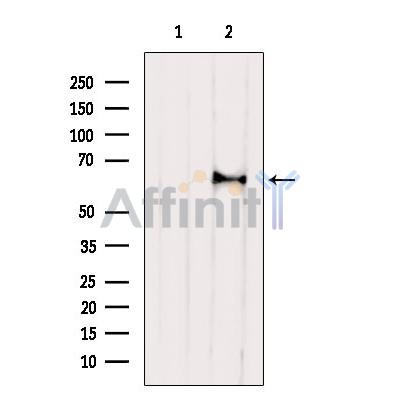ASAH1 Antibody - #DF12248
| Product: | ASAH1 Antibody |
| Catalog: | DF12248 |
| Description: | Rabbit polyclonal antibody to ASAH1 |
| Application: | WB IHC |
| Reactivity: | Human, Mouse, Rat, Monkey |
| Prediction: | Pig, Bovine, Horse, Sheep, Rabbit, Dog, Chicken, Xenopus |
| Mol.Wt.: | 60-65 kDa; 45kD(Calculated). |
| Uniprot: | Q13510 |
| RRID: | AB_2845053 |
Related Downloads
Protocols
Product Info
*The optimal dilutions should be determined by the end user. For optimal experimental results, antibody reuse is not recommended.
*Tips:
WB: For western blot detection of denatured protein samples. IHC: For immunohistochemical detection of paraffin sections (IHC-p) or frozen sections (IHC-f) of tissue samples. IF/ICC: For immunofluorescence detection of cell samples. ELISA(peptide): For ELISA detection of antigenic peptide.
Cite Format: Affinity Biosciences Cat# DF12248, RRID:AB_2845053.
Fold/Unfold
AC; ACDase; Acid CDase; Acid ceramidase; Acid ceramidase precursor; Acid ceramidase subunit beta; Acylsphingosine deacylase; ASAH 1; ASAH; ASAH1; ASAH1_HUMAN; FLJ21558; FLJ22079; N acylsphingosine amidohydrolase (acid ceramidase) 1; N acylsphingosine amidohydrolase 1; N acylsphingosine amidohydrolase; N-acylsphingosine amidohydrolase; N-acylsphingosine deacylase; PHP; PHP32; Putative 32 kDa heart protein; SMAPME;
Immunogens
A synthesized peptide derived from human ASAH1, corresponding to a region within N-terminal amino acids.
- Q13510 ASAH1_HUMAN:
- Protein BLAST With
- NCBI/
- ExPASy/
- Uniprot
MPGRSCVALVLLAAAVSCAVAQHAPPWTEDCRKSTYPPSGPTYRGAVPWYTINLDLPPYKRWHELMLDKAPVLKVIVNSLKNMINTFVPSGKIMQVVDEKLPGLLGNFPGPFEEEMKGIAAVTDIPLGEIISFNIFYELFTICTSIVAEDKKGHLIHGRNMDFGVFLGWNINNDTWVITEQLKPLTVNLDFQRNNKTVFKASSFAGYVGMLTGFKPGLFSLTLNERFSINGGYLGILEWILGKKDVMWIGFLTRTVLENSTSYEEAKNLLTKTKILAPAYFILGGNQSGEGCVITRDRKESLDVYELDAKQGRWYVVQTNYDRWKHPFFLDDRRTPAKMCLNRTSQENISFETMYDVLSTKPVLNKLTVYTTLIDVTKGQFETYLRDCPDPCIGW
Predictions
Score>80(red) has high confidence and is suggested to be used for WB detection. *The prediction model is mainly based on the alignment of immunogen sequences, the results are for reference only, not as the basis of quality assurance.
High(score>80) Medium(80>score>50) Low(score<50) No confidence
Research Backgrounds
Lysosomal ceramidase that hydrolyzes sphingolipid ceramides into sphingosine and free fatty acids at acidic pH. Ceramides, sphingosine, and its phosphorylated form sphingosine-1-phosphate are bioactive lipids that mediate cellular signaling pathways regulating several biological processes including cell proliferation, apoptosis and differentiation. Has a higher catalytic efficiency towards C12-ceramides versus other ceramides. Also catalyzes the reverse reaction allowing the synthesis of ceramides from fatty acids and sphingosine. For the reverse synthetic reaction, the natural sphingosine D-erythro isomer is more efficiently utilized as a substrate compared to D-erythro-dihydrosphingosine and D-erythro-phytosphingosine, while the fatty acids with chain lengths of 12 or 14 carbons are the most efficiently used. Has also an N-acylethanolamine hydrolase activity. By regulating the levels of ceramides, sphingosine and sphingosine-1-phosphate in the epidermis, mediates the calcium-induced differentiation of epidermal keratinocytes. Also indirectly regulates tumor necrosis factor/TNF-induced apoptosis (By similarity). By regulating the intracellular balance between ceramides and sphingosine, in adrenocortical cells, probably also acts as a regulator of steroidogenesis.
May directly regulate steroidogenesis by binding the nuclear receptor NR5A1 and negatively regulating its transcriptional activity.
N-glycosylated.
Proteolytically cleaved into two chains alpha and beta that remain associated via a disulfide bond. Cleavage gives rise to a conformation change that activates the enzyme. The same catalytic Cys residue mediates the autoproteolytic cleavage and subsequent hydrolysis of lipid substrates. The beta chain may undergo an additional C-terminal processing.
Lysosome. Secreted.
Note: Secretion is extremely low and localization to lysosomes is mannose-6-phosphate receptor-dependent.
Nucleus. Cytoplasm.
Note: A localization to the nucleus and the cytoplasm has also been reported for ASAH1, most probably for isoforms devoid of a signal peptide.
Broadly expressed with higher expression in heart.
Belongs to the acid ceramidase family.
Research Fields
· Cellular Processes > Transport and catabolism > Lysosome. (View pathway)
· Environmental Information Processing > Signal transduction > Sphingolipid signaling pathway. (View pathway)
· Metabolism > Lipid metabolism > Sphingolipid metabolism.
· Metabolism > Global and overview maps > Metabolic pathways.
Restrictive clause
Affinity Biosciences tests all products strictly. Citations are provided as a resource for additional applications that have not been validated by Affinity Biosciences. Please choose the appropriate format for each application and consult Materials and Methods sections for additional details about the use of any product in these publications.
For Research Use Only.
Not for use in diagnostic or therapeutic procedures. Not for resale. Not for distribution without written consent. Affinity Biosciences will not be held responsible for patent infringement or other violations that may occur with the use of our products. Affinity Biosciences, Affinity Biosciences Logo and all other trademarks are the property of Affinity Biosciences LTD.
